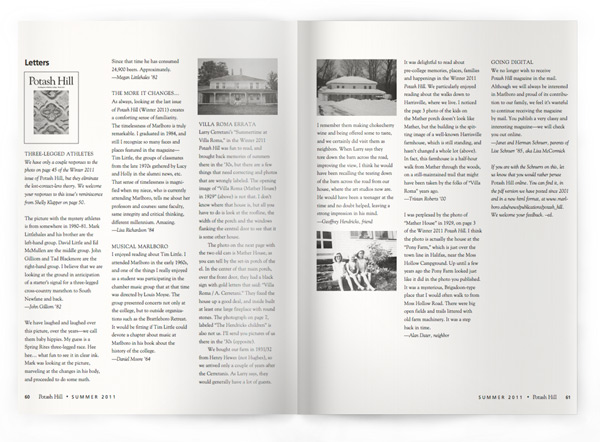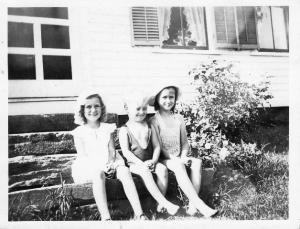Letters

Three-Legged Athletes
We have only a couple responses to the photo on page 45 of the Winter 2011 issue of Potash Hill, but they eliminate the lost-contact-lens theory. We welcome your responses to this issue’s reminiscence from Shelly Klapper.
The picture with the mystery athletes is from somewhere in 1980–81. Mark Littlehales and his brother are the left-hand group. David Little and Ed McMullen are the middle group. John Gilliom and Tad Blackmore are the right-hand group. I believe that we are looking at the ground in anticipation of a starter’s signal for a three-legged cross-country marathon to South Newfane and back.
—John Gilliom ’82
We have laughed and laughed over this picture, over the years—we call them baby hippies. My guess is a Spring Rites three-legged race. Hee hee… what fun to see it in clear ink. Mark was looking at the picture, marveling at the changes in his body, and proceeded to do some math. Since that time he has consumed 24,900 beers. Approximately.
—Megan Littlehales ’82
The More It Changes…
As always, looking at the last issue of Potash Hill (Winter 2011) creates a comforting sense of familiarity. The timelessness of Marlboro is truly remarkable. I graduated in 1984, and still I recognize so many faces and places featured in the magazine—Tim Little, the groups of classmates from the late 1970s gathered by Lucy and Holly in the alumni news, etc. That sense of timelessness is magnified when my niece, who is currently attending Marlboro, tells me about her professors and courses: same faculty, same integrity and critical thinking, different millennium. Amazing.
—Lisa Richardson ’84
Musical Marlboro
I enjoyed reading about Tim Little. I attended Marlboro in the early 1960s, and one of the things I really enjoyed as a student was participating in the chamber music group that at that time was directed by Louis Moyse. The group presented concerts not only at the college, but to outside organizations such as the Brattleboro Retreat. It would be fitting if Tim Little could devote a chapter about music at Marlboro in his book about the history of the college.
—Daniel Moore ’64
Villa Roma Errata
Larry Cerretani’s “Summertime at Villa Roma,” in the Winter 2011 Potash Hill was fun to read, and brought back memories of summers there in the ’30s, but there are a few things that need correcting and photos that are wrongly labeled. The opening image of “Villa Roma (Mather House) in 1929” is not that. I don’t know where that house is, but all you have to do is look at the roofline, the width of the porch and the windows flanking the central door to see that it is some other house.

The photo on the next page with the two old cars is Mather House, as you can tell by the set-in porch of the el. In the center of that main porch, over the front door, they had a black sign with gold letters that said: “Villa Roma / A. Cerretani.” They fixed the house up a good deal, and inside built at least one large fireplace with round stones. The photograph on page 7, labeled “The Hendricks children” is also not us. I’ll send you pictures of us there in the ’30s.
We bought our farm in 1931/32 from Henry Hewes (not Hughes), so we arrived only a couple of years after the Cerretanis. As Larry says, they would generally have a lot of guests. I remember them making chokecherry wine and being offered some to taste, and we certainly did visit them as neighbors. When Larry says they tore down the barn across the road, improving the view, I think he would have been recalling the tearing down of the barn across the road from our house, where the art studios now are. He would have been a teenager at the time and no doubt helped, leaving a strong impression in his mind.
—Geoffrey Hendricks, friend
It was delightful to read about pre-college memories, places, families and happenings in the Winter 2011 Potash Hill. We particularly enjoyed reading about the walks down to Harrisville, where we live. I noticed the page 3 photo of the kids on the Mather porch doesn’t look like Mather, but the building is the spitting image of a well-known Harrisville farmhouse, which is still standing, and hasn’t changed a whole lot. In fact, this farmhouse is a half-hour walk from Mather through the woods, on a still-maintained trail that might have been taken by the folks of “Villa Roma” years ago.
—Tristan Roberts ’00
I was perplexed by the photo of “Mather House” in 1929, on page 3 of the Winter 2011 Potash Hill. I think the photo is actually the house at the “Pony Farm,” which is just over the town line in Halifax, near the Moss Hollow Campground. Up until a few years ago the Pony Farm looked just like it did in the photo you published. It was a mysterious, Brigadoon-type place that I would often walk to from Moss Hollow Road. There were big open fields and trails littered with old farm machinery. It was a step back in time.
—Alan Dater, neighbor
Going Digital
We no longer wish to receive Potash Hill magazine in the mail. Although we will always be interested in Marlboro and proud of its contribution to our family, we feel it’s wasteful to continue receiving the magazine by mail. You publish a very classy and interesting magazine—we will check you out online.
—Janet and Herman Schnurr, parents of Lise Schnurr ’85, aka Lisa McCormick
If you are with the Schnurrs on this, let us know that you would rather peruse Potash Hill online. You can find it, in the pdf version we have posted since 2001 and in a new html format you are looking at now, on our website. We welcome your feedback. –ed.
